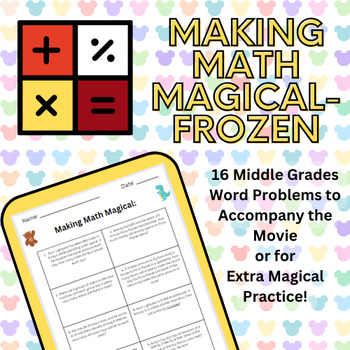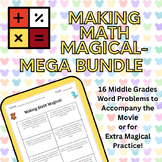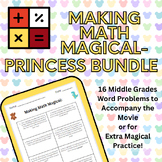Making Math Magical- Frozen (After Testing Activity/Movie Day/Disney Week)
Caffeinated Mathematics
39 Followers
Grade Levels
4th - 8th, Homeschool
Subjects
Resource Type
Standards
CCSS6.G.A.1
CCSS6.SP.A.3
CCSS6.NS.A.1
CCSS6.NS.B.2
CCSS6.NS.B.4
Formats Included
- PDF
Pages
4 pages
Caffeinated Mathematics
39 Followers
Also included in
- Embark on a magical journey with Disney-themed math worksheet designed for middle grades students! This enchanting worksheet features a collection of captivating word problems that blend the charm of beloved Disney characters and settings with fundamental math concepts.This set of 16 question workshPrice $15.75Original Price $22.50Save $6.75
- Embark on a magical journey with Disney-themed math worksheet designed for middle grades students! This enchanting worksheet features a collection of captivating word problems that blend the charm of beloved Disney characters and settings with fundamental math concepts.This set of 16 question workshPrice $6.00Original Price $7.50Save $1.50
Description
The end of the school year after testing can be a challenge for students to stay focused. This math worksheet goes along with Disney's Frozen. The worksheet consists of 6th grade math questions but could be used with other grade levels as well.
Some of the topics included are: decimal operations, multiplying fractions, greatest common factor, mean, range, mode, ratios, volume, unit rate, and area of a rectangle.
Looking for other "Making Math Magical" Products?
Total Pages
4 pages
Answer Key
Included
Teaching Duration
90 minutes
Report this resource to TPT
Reported resources will be reviewed by our team. Report this resource to let us know if this resource violates TPT’s content guidelines.
Standards
to see state-specific standards (only available in the US).
CCSS6.G.A.1
Find the area of right triangles, other triangles, special quadrilaterals, and polygons by composing into rectangles or decomposing into triangles and other shapes; apply these techniques in the context of solving real-world and mathematical problems.
CCSS6.SP.A.3
Recognize that a measure of center for a numerical data set summarizes all of its values with a single number, while a measure of variation describes how its values vary with a single number.
CCSS6.NS.A.1
Interpret and compute quotients of fractions, and solve word problems involving division of fractions by fractions, e.g., by using visual fraction models and equations to represent the problem. For example, create a story context for (2/3) ÷ (3/4) and use a visual fraction model to show the quotient; use the relationship between multiplication and division to explain that (2/3) ÷ (3/4) = 8/9 because 3/4 of 8/9 is 2/3. (In general, (𝘢/𝘣) ÷ (𝘤/𝘥) = 𝘢𝘥/𝘣𝘤.) How much chocolate will each person get if 3 people share 1/2 lb of chocolate equally? How many 3/4-cup servings are in 2/3 of a cup of yogurt? How wide is a rectangular strip of land with length 3/4 mi and area 1/2 square mi?
CCSS6.NS.B.2
Fluently divide multi-digit numbers using the standard algorithm.
CCSS6.NS.B.4
Find the greatest common factor of two whole numbers less than or equal to 100 and the least common multiple of two whole numbers less than or equal to 12. Use the distributive property to express a sum of two whole numbers 1–100 with a common factor as a multiple of a sum of two whole numbers with no common factor. For example, express 36 + 8 as 4 (9 + 2).






